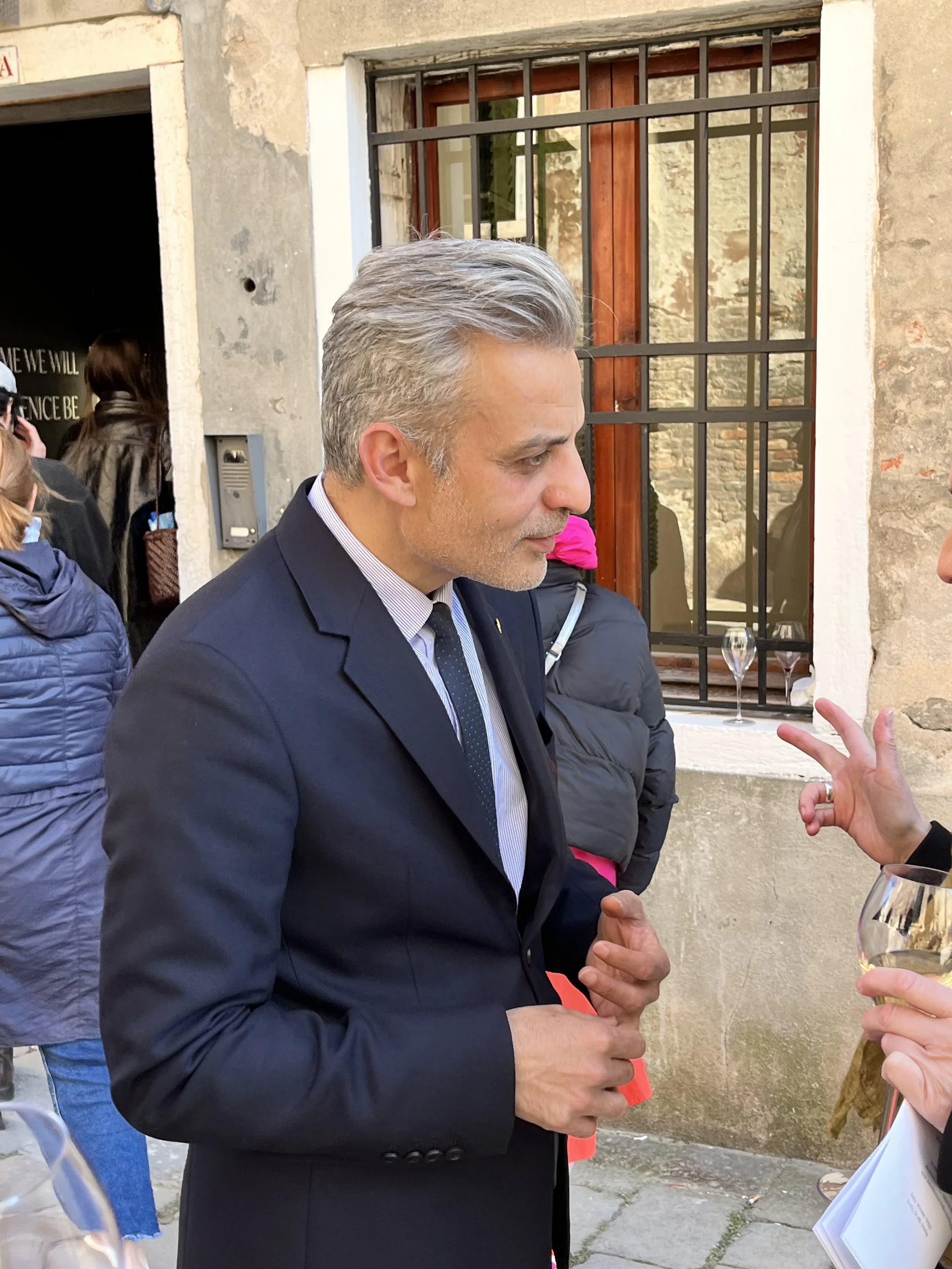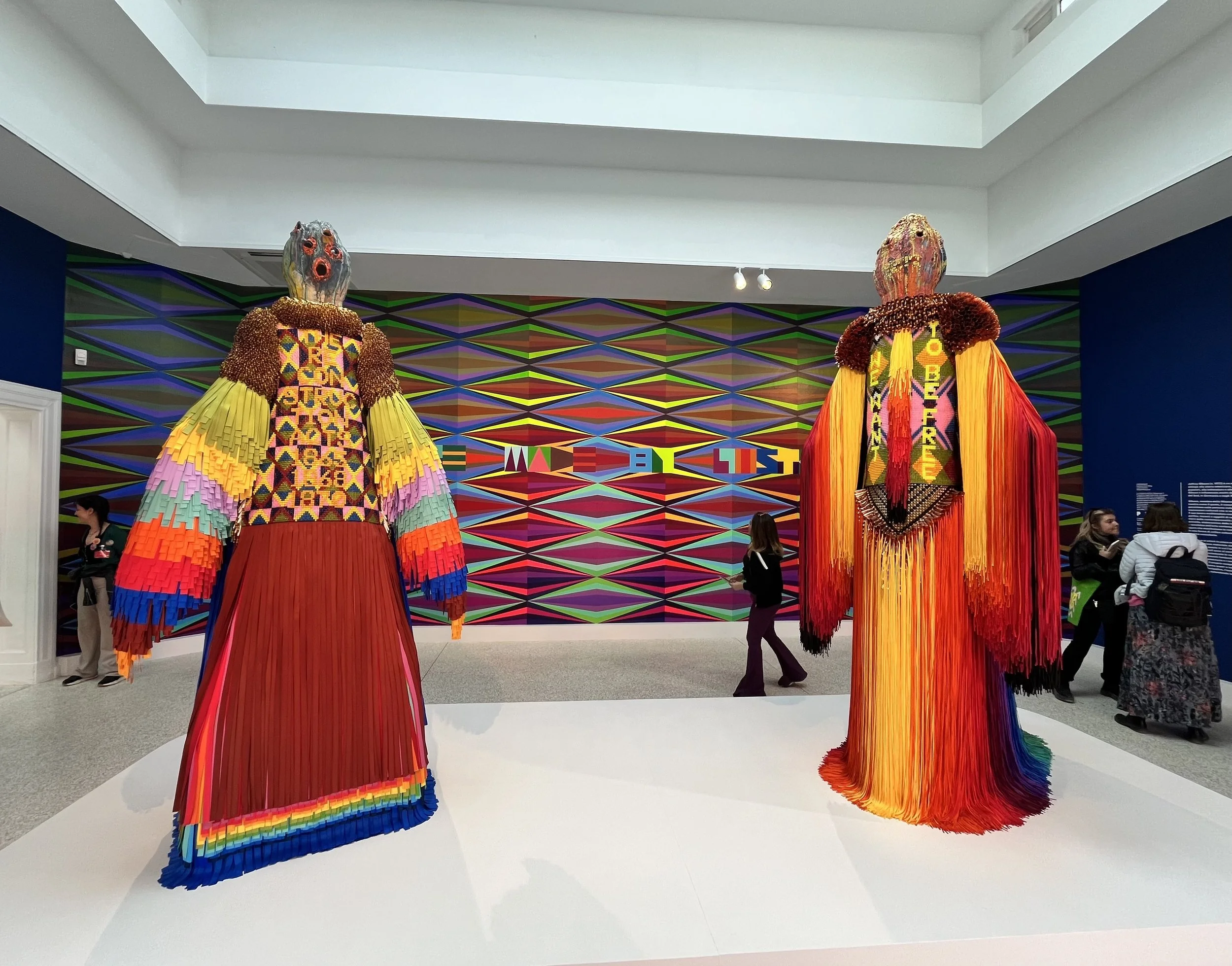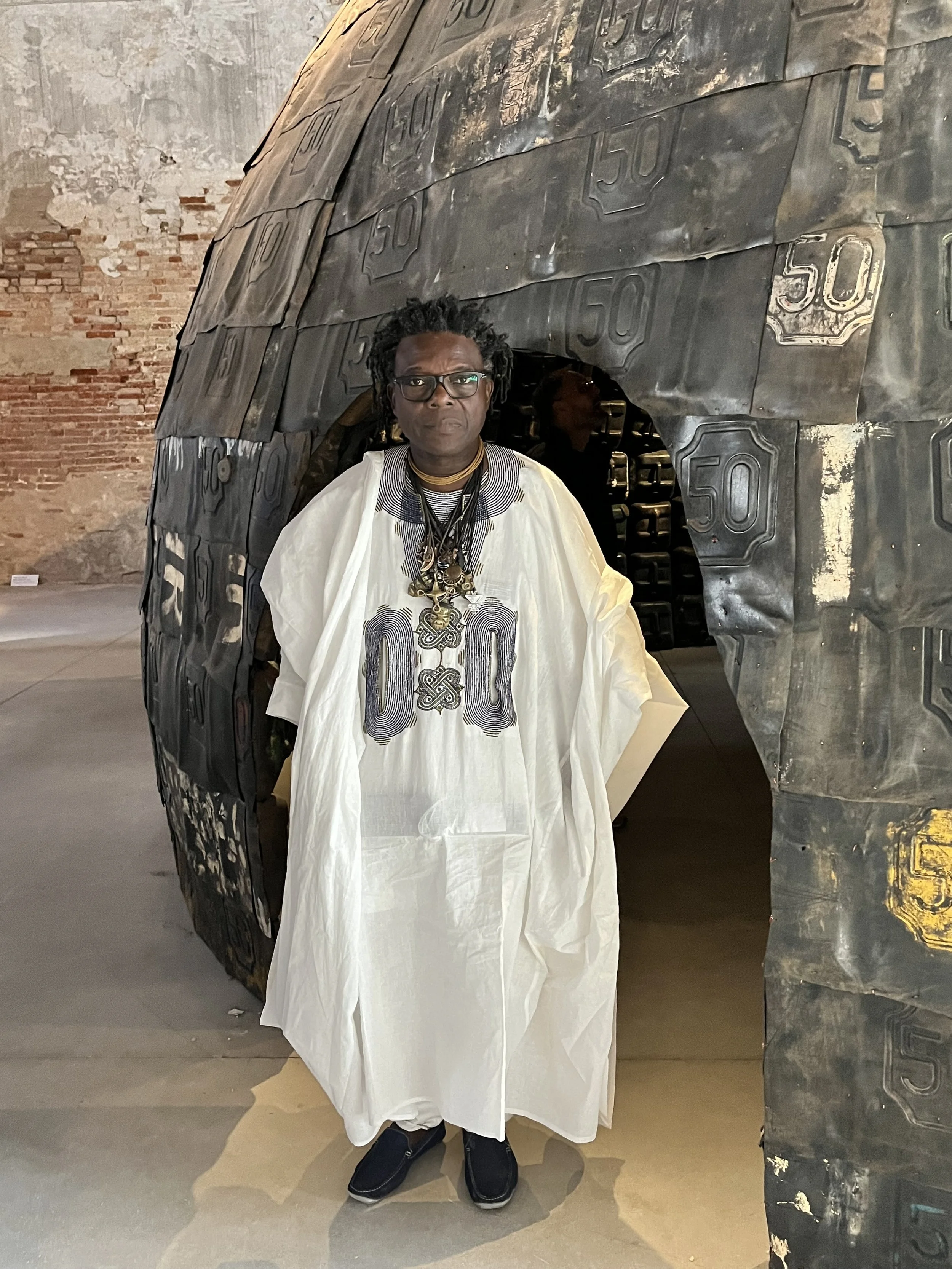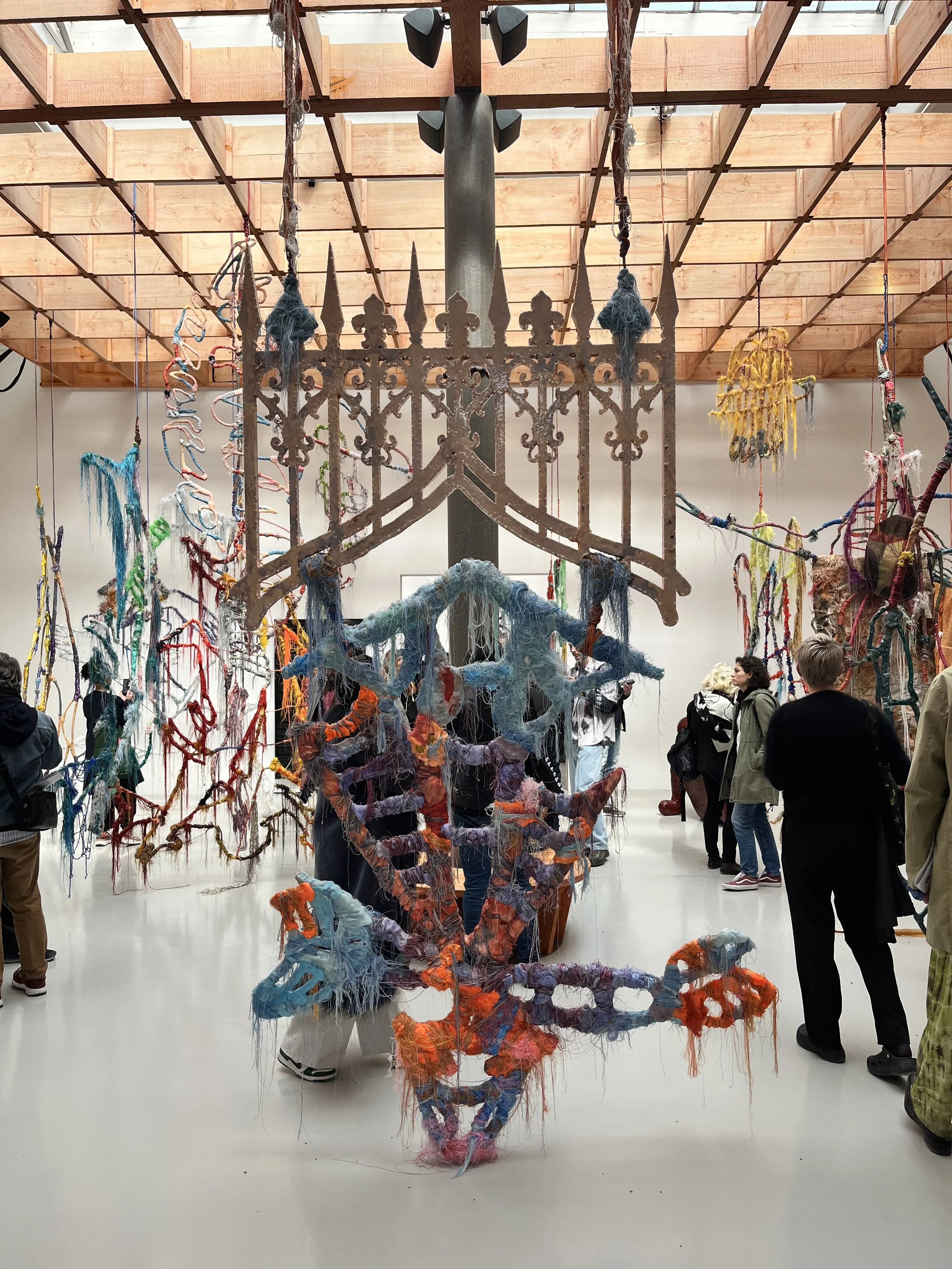The Venice Biennale: For Foreigners, By Foreigners
Two monumental sculptures by Jeffrey Gibson in the U.S. Pavilion. Photograph by Elizabeth Freeman.
Dodging geopolitics and seeking affirmation of its relevance, the 60th Venice Biennale opened to the public today, announcing itself as both an essential challenge to global notions of identity and belonging and a captivating revelation of art’s elite voices and perspectives.
Artists, curators and collectors got their first look at this newest incarnation of the world’s longest-running contemporary art exhibition and its theme Stranieri Ovunque — Foreigners Everywhere in the days leading up to Saturday’s public opening. What they saw was work that attacked tired notions of ego, intolerance, exclusion and cynicism with multi-sensual installations featuring racing color, immersive sound and diversiform performance, along with blends of contemporary thought, historic sweep and non-escapist hope.
Founded in 1895, the venerable “Olympics of art” has endured two world wars, the Great Depression, pandemics, instability of every description, and generational changes in the nature of art and the markets for it.
Biennale curator Adriano Pedrosa discusses the lead up to the opening of 60th Vence Biennale.
Yet, here it is, open to the world with more than 55 national pavilions including first-timers like Benin, Ethiopia, Tanzania and Timor-Leste. The number of artists showcased in the main exhibitions climbed this year to 331, an increase of more than 100 since the 2022 edition. Add to that, dozens of independent collateral events scattered about the city and you’ve got a worthy global celebration of art in a city many consider an artistic wonder in and of itself.
The Biennale’s opening events come as bullets and bombs fly in Ukraine and Gaza and as Israel is under attack by Iranian drones. Some sought the exclusion of Israel for its conduct in Gaza and Iran for its treatment of women, but the Biennale dodged both requests. In response, the Biennale said simply that “all countries recognised by the Italian Republic may autonomously request to participate.” Russia, meanwhile, decided not to participate, lending its pavilion to Bolivia.
Outside the main hall at the Biennale. Photograph by Elizabeth Freeman.
What the Biennale refused to do, the Israeli creative team (including artist Ruth Patir) did themselves, refusing to open the pavilion until there is a cease-fire and hostage deal in Gaza. “The art can wait, but the women, children and people living through hell cannot,” the group said in a statement. At the same time, hundreds protested the war in Gaza outside the Israeli and United States pavilions and elsewhere in Venice.
Local politics were on the minds of some event participants who feared the 2022 election of Giorgia Meloni as Italian prime minister and her appointment of rightwing journalist Pietrangelo Buttafuoco as the new president of the Biennale could lead to clashes over the politics of art. It didn’t happen, but Buttafuoco did not assume office until last month, at which point planning for the event was well underway. “I had complete freedom and autonomy to develop the project,” Biennale curator Adriano Pedrosa told the New York TImes.
The theme of the Biennale, Stranieri Ovunque — Foreigners Everywhere, suggests contemplation around the absurd predicament faced by 8 billion people of different races, religions, nationalities, genders and sexual identities all hurtling through the universe on a single, fragile, blue marble and, all, in fact, foreigners.
“The expression Stranieri Ovunque has several meanings,” Pedrosa said. “First of all, that wherever you go and wherever you are you will always encounter foreigners—they/we are everywhere. Secondly, that no matter where you find yourself, you are always truly, and deep down inside, a foreigner,” he added.
But it’s about much more than nationality or ethnicity. “I take this image of the foreigner and unfold it into the queer, the outsider, the Indigenous,” Pedrosa told the Times.
Putting aside the world’s fractured politics and ceaseless instability to focus blindly for a moment on the Biennale’s raison d'etre, here’s a first look at a few of the most anticipated pavilions in the Biennale’s 60th incarnation.
UNITED STATES
Two monumental sculptures by Jeffrey Gibson in the U.S. Pavilion. Photograph by Elizabeth Freeman.
The U.S. Pavilion has been turned over to the inimitable Jeffrey Gibson, a queer Choctaw and Cherokee artist who emerges as a torchbearer for contemporary native American art and whose transformative vision unfolds as a mesmerizing tapestry of color, texture, and cultural resonance.
The exhibition, titled “the space in which to place me,” is a sensory party of intense color and complex geometry that leaps at attendees from the exterior of the pavilion, before consuming them and confronting them with the same on the inside. There are rich and exciting geometric paintings in luminescent hues proceeding across the pavilion’s rooms; there is intricate beadwork, fringe, and stitching leveraged in figurative sculptures of people and animals; there are flags, not of nations, but suggesting instead a oneness across spectrums.
“The last 15 years of my career have been about turning inward and trying to make something I really wanted to see in the world,” Gibson, 51, told the New York Times. “Now I want to expand the way people think about Indigeneity.”
Gibson brought not only his art, but also Native American dancers and singers from the Oklahoma Fancy Dancers and Colorado Inter-Tribal Dancers to perform a Jingle Dance Program, regularly around and atop the pedestals that comprise his monumental red sculpture erected outside the pavilion's entrance.
BRAZIL, renamed Hãhãwpuá Pavilion
Brazil, Pedrosa’s home country, is represented by luminary firebrand and crusader Glicéria Tupinambá, also known as Célia Tupinambá, the first Indigenous artist ever to do their country’s pavilion solo. The symbolic metamorphosis of the Brazilian pavilion into the “Hãhãwpuá Pavilion” serves as an homage to the ancestral Indigenous lands that once thrived in Brazil, while Tupinambá’s work provides an echo of the intricate tapestry of historical narratives and identities that have interwoven to shape the nation's essence.
The exhibition, called “Ka’a Pûera: nós somos pássaros que andam” [Ka’a Pûera: we are walking birds], features as its centerpiece a feathered cape made by Tupinambá with help from members of her community in Bahia.
The mantle is modeled on the 17th-century capes that were plundered by European conquerors centuries ago. Glicéria, who was jailed in 2010 for speaking out on police brutality, wrote letters to six European museums demanding the return of the few mantles that still exist today. The Nationalmuseet, Denmark’s National Museum, recently announced plans to repatriate one Tupinambá cape.
Tupinambá's contemporary mantle is displayed along with a video installation by Olinda Tupinambá and an artistic creation fashioned from fishing nets by Ziel Karapotó. Curators Denilson Baniwa, Arissana Pataxó, and Gustavo Caboco Wapichana said the installation “will tell a story of indigenous resistance in Brazil, the strength of the body present in the reconquest of the territory and in the adaptation to climate emergencies.”
Romuald Hazoume of Benin standing before his monumental sculpture which he says captures energy and transplants power into viewers as they enter the structure made from used oil cans. Photograph by Elizabeth Freeman.
THE REPUBLIC OF BENIN
Storming the Biennale’s gates for the first time is The Republic of Benin, with an exhibition called Everything Precious Is Fragile, an audacious effort that plunges deep into Benin's history to unfurl threads of the slave trade, the enigmatic Amazon motif, spiritual reveries, and the mystical Vodun religion.
Benin is represented by artists Ishola Akpo, Moufouli Bello, Romuald Hazoumè and Chloé Quenum, leveraging their photography, painting and sculpture into a discussion of themes of spirituality, colonialism, Black feminism and how women are represented.
Azu Nwagbogu said he approached the job of curating the pavilion “a little bit like an anthropologist.” In an interview with Frieze, he said he met with Benin’s “historians, chief priests, voodoo masters, pontiffs…. I wanted to know what they felt about the state of affairs in the world today. Why things are out of kilter. And each one of them said it is because women have been displaced from their traditional role of equality and power in society.”
“Venice is part of the journey, a soft-power political move to show the international stage that we have something to say in the context of the broader culture universe,” Babalola Jean-Michel Hervé Abimbola, Benin’s minister of culture, tourism and the arts, said in an interview with Financial Times.
Work by sculptor Julien Creuzet hangs in the French Pavilion. Photograph by Elizabeth Freeman.
FRANCE
France turned to rising young sculptor Julien Creuzet as its emissary to the Biennale. A maverick known for his avant-garde fusion of plastics, rope and other materials delves into the complexities of his French-Caribbean lineage to enact a creolized installation, a harmonious blend of disparate materials, narratives, forms, and gestures that dance in unison.
In an unusual kick-off to the French exhibition, Creuzet launched the French Pavilion in Martinique, in the French Antilles, where he spoke of himself as an outremer (overseas) citizen of France in Martinique. "What I want to offer visitors to this pavilion is a complex and sensory zone of confluence, a deeply lived experience. For me, this is what space is about. It is a crossway, a place where anything may be encountered, above all oneself," he said.
His installation, called Attila cataract your source at the feet of the green peaks will end up in the great sea blue abyss we drowned in the tidal tears of the moon, includes paintings; colorful, tattered objects hanging from a ceiling lattice; and bronze cast sculpture, along with sound, video and aroma via vessels containing water and lavender.
"What I want to offer visitors to this pavilion is a complex and sensory zone of confluence, a deeply lived experience. For me, this is what space is about. It is a crossway, a place where anything may be encountered, above all oneself," Creuzet said.
The 60th Venice Biennale opened to the public at venues across the city April 20 and runs through November 24.
Originally published by Whitehot Magazine.






